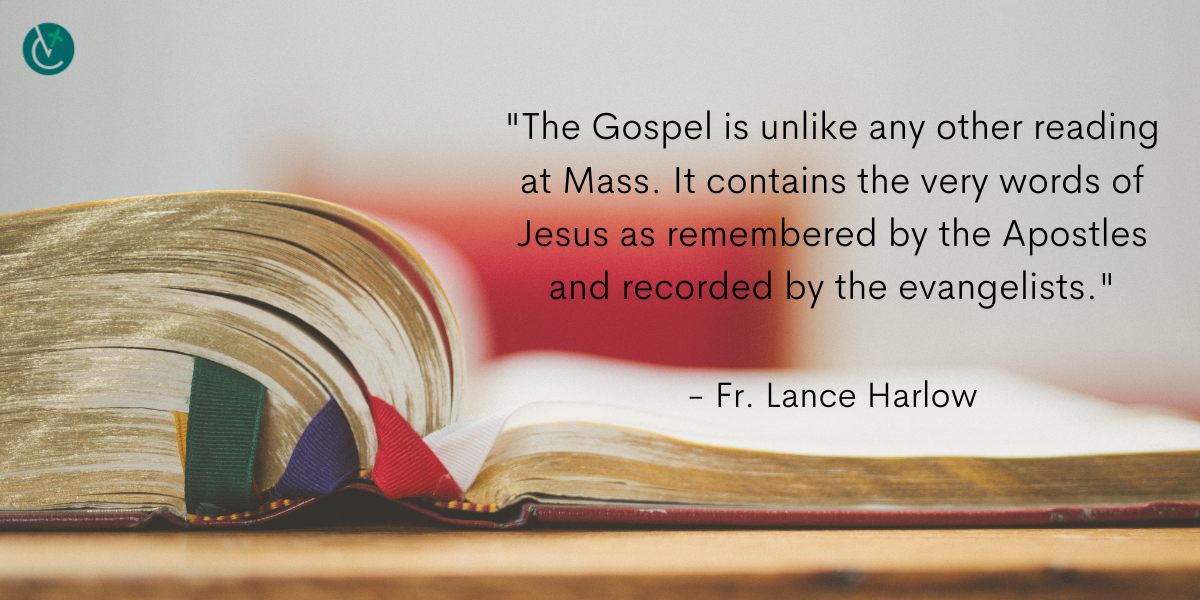
The Gospel at Mass
The proclamation of the Gospel at Mass has its own unique liturgical character. One notices a certain solemnity as the congregation prepares to hear the words of Jesus expressed by a series of liturgical gestures which precede and accompany the Gospel:
- The congregation stands. It is well known that the Catholic Mass contains a lot of physical movement depending upon the degree of reverence for what is being experienced at any given moment: from sitting to standing to kneeling in that hierarchical order. The congregation and all assembled stand out of reverence at the sound of “the royal summons;” otherwise called the Alleluia or Gospel acclamation.
- Alleluia is a Hebrew word which means “praise God.” It calls the congregation to joyful attention that the King of Heaven and Earth is about to speak to us in His very words through the Gospel. The Alleluia is not a solo. It is intoned by the choir or priest, but then immediately each member of the congregation joins in a unified response to praise God. It should always be sung when appropriate or omitted if it cannot be sung. Each person at Mass proclaims this Alleluia — it is not a representative action just between the priest and God the Father; it is communal.
- Priest’s Prayer. The priest offers a silent prayer which the people do not hear as he bows before the altar. Bowing is a sign of submission to one who is greater. The priest bows before the altar on his way to the ambo or pulpit. He says the following supplication: “Cleanse my heart and my lips, Almighty God, that I may worthily proclaim your holy Gospel.” Like Isaiah, the priest recognizes his own unworthiness to speak the Word of God and prays for a pure heart to be able to proclaim the Gospel because of its intrinsic holiness.
- If there is a Book of the Gospel, it is elevated and carried by a deacon in procession from the altar to the pulpit. If not, the priest reads from the lectionary. There is a greeting and introduction by the deacon or priest: “The Lord be with you. [And with your spirit]. A reading from the Holy Gospel according to N.] The congregation responds: “Glory to you O Lord.” Two levels of praise have now preceded the Gospel before it is even read: the Alleluia and Glory to the Father. The book may be incensed depending upon circumstances.
- With the greeting, the congregation makes a triple sign of the cross over the forehead, lips and heart. By that ritual action, we claim our minds, speech and affections for Jesus. It is reminiscent of the Rite of Baptism when the priest asks God’s blessing upon the ears and mouth of the baby who has just been baptized. Not only are we to hear the Gospel at Mass, but with minds renewed we are to proclaim it when we leave Mass and go back into the world.
- After the priest has proclaimed the Gospel, he kisses the book and says another silent prayer: “Through the words of the Gospel may our sins be wiped away.” By this prayer, the priest prays that those who hear about the mighty works of Jesus may convert from their sins to experience a new life of holiness as did those who heard Jesus’s words during His own lifetime.
The Gospel is unlike any other reading at Mass. It contains the very words of Jesus as remembered by the Apostles and recorded by the evangelists. Its presence at Mass is surrounded by the greatest dignity and praise as expressed in the beautiful liturgical actions and prayers which accompany it. The power of the Gospel is to create new life in those who hear it, new life for you and for me.
—Father Lance Harlow is pastor of Corpus Christi Parish based in St. Johnsbury.
—Originally published in the Summer 2022 issue of Vermont Catholic magazine.

